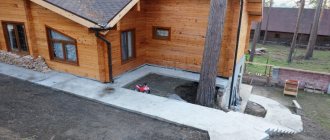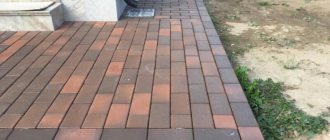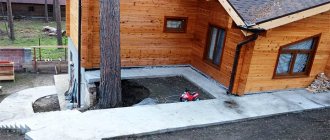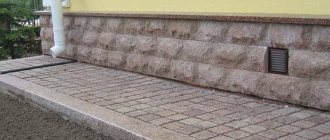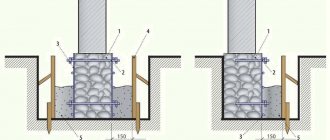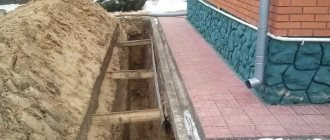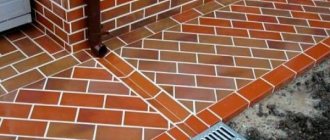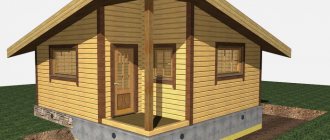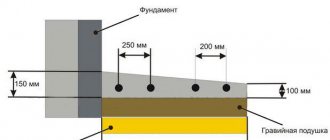The blind area is a waterproof tape that runs around the perimeter of the entire house. It is made at a slight slope from the building for better drainage and drainage of rainwater. With a creative approach to design, it will become an additional decor for the yard, a convenient path around the building.
This article will help you understand the types, suitable materials, and the procedure for arranging a blind area around the house.
Purpose of the blind area
The main purpose of the blind area is to protect the foundation from high humidity after precipitation, from freezing and to prevent its subsidence.
A continuous strip prevents the soil around the residential building from getting wet and the base of the structure being saturated with moisture. If water penetrates into a foundation with poor or damaged waterproofing, then during severe frosts the concrete begins to break and over time, individual sections will sag. Cracks will appear on the base and walls of the house.
To avoid such problems, it is recommended to equip a high-quality blind area at the stage of building a house.
A monolithic tape with a layer of insulation will ensure reliable thermal insulation of the foundation, the floor in the house will not be cold, and heating costs in winter will be reduced.
If you finish the blind area beautifully, it will become part of the decor of the facade or yard, and if you lay it out with paving slabs, it will serve as a practical path between the house and other buildings on the site (garage, gazebo).
Laying it on a slope turns it into a low tide, so that rain and melted snow do not accumulate near the house, but flow away from it.
What is a blind area, what is its importance
First you need to figure out what the benefits of the blind area are. Its main task is to protect the foundation from moisture; sufficiently high-quality protection will prevent a very negative phenomenon, subsidence of the foundation, which over time can lead to the destruction of the house.
In addition to its technical purpose, the blind area plays the role of decorative finishing of the area adjacent to the house. It frames the entire perimeter of the house, allowing you to walk around it comfortably in any weather.
A well-made blind area will eliminate the possibility of the house being washed away by storm or melt water; as a result of this negative process, the soil is moistened unevenly, which threatens the rapid appearance of cracks on the foundation or walls.
An equally important point will be the blind area, properly constructed if the house stands on heaving soil. Sometimes one winter is enough to destroy a house on soils prone to swelling. The problem is that water-saturated soil causes uneven swelling. The pressure exerted by this can sometimes cause serious damage.
Analyzing the essence of this problem, we can conclude that the blind area on heaving soils should be insulated.
Experts say that the blind area should be built immediately after finishing the cladding of the walls of the house and its base. Postponing installation for a whole year, as some developers do, is quite dangerous.
Learn more about the benefits of a blind area and the rules for its construction in the video:
SNiP requirements
The blind area of the house, its size and arrangement are regulated by a number of regulations. Their list includes:
- GOST 9128-97. Contains the basic requirements for the composition and use of asphalt concrete, the procedure for determining the angle of inclination of a blind area made of this material.
- GOST 7473-94. Describes the requirements and quality criteria for concrete mixtures for blind areas. Recommendations for use.
- SNiP 2.04.02-84. This standard regulates the construction of a blind area around a well. Indicates how to calculate the tape angle.
- SNiP III-10-75. On the improvement of personal gardens. Contains recommendations on where to lay the blind area.
- SP 22.13330.2016. Foundations of buildings and structures. Updated edition of SNiP 2.02.01-83* (with Amendments No. 1, 2, 3). Foundations of buildings and structures. Here are recommendations regarding the size of the blind area on different soils. Formulas for calculating the depth of foundations are given. You can view the full version of the official document at the link: https://docs.cntd.ru/document/456054206.
According to the current set of rules and regulations, on normal soil the width of the blind area should be made from 60 cm, on sagging soil - from 1 m. It is recommended to retreat at least 20 cm from the roof overhang.
The last requirement is not necessary to follow if a full-fledged drainage system is installed on the roof to collect precipitation.
How to properly make a blind area around the house
A blind area is a protective path with a hard or bulk coating, arranged adjacent to the wall along the entire perimeter of the building. Its main purpose is to drain rain and melt water falling from the roof near the foundation and contributing to its premature destruction.
In addition, it is used as a convenient pedestrian passage and decorative design when landscaping the area adjacent to the house. The use of dense or bulk insulation when constructing a blind area allows you to protect the foundation from the effects of low temperatures and reduce heat loss through the enclosing structures.
A fairly simple device for such a protective coating simultaneously solves several important problems related to protection and improvement, without requiring large financial investments. At the same time, you can do it yourself, without inviting specialist builders for this.
For pile, deep columnar and screw foundations, the presence of a blind area is not mandatory, but it is often made as an element of landscaping and as a convenient pedestrian path.
Design of the blind area
Protective coating must be done around the entire perimeter of the house, since it is necessary to protect the entire foundation mass. The basic requirements on how to properly make a blind area around a house with your own hands are set out in SNiP 2.02.
01-83, which says that on normal soils its width should be at least 600 mm, and on subsidence soils - at least a meter. In general, the width of the covering should extend at least 200 mm beyond the protruding roof section.
The maximum width is not regulated.
General drawing of the blind area.
The hard covering must be laid on a dense base with a thickness of at least 15 cm. The slope of the blind area from the building is at least 0.03%, with the lower edge exceeding the planning mark by more than 5 cm. Storm water must be drained into storm drains or gutters.
A high-quality insulated blind area should consist of three main layers:
- surface waterproof;
- underlying gravel or a mixture of crushed stone and sand;
- insulating polystyrene foam.
Geotextiles can be used as an additional layer, which will be a fairly reliable waterproofing against groundwater rising in the spring, and will also prevent the possible germination of weeds.
Top layer coating materials
The materials used for the top layer when constructing a blind area are quite diverse and have their own distinctive features. The simplest and most inexpensive is ordinary clay.
With its help you can create a fairly reliable hydraulic lock. Such protection is often found in rural areas.
However, modern developers have long abandoned such primitive materials and are using more efficient technologies.
Options.
The most common option for making a blind area is to install a concrete covering. You can simply and quickly install it yourself without investing large amounts of money. At the same time, concrete is characterized by high strength and durability, and also allows it to be subsequently covered with paving slabs to improve its appearance.
The paving stones can be laid on a compacted sand bed. It has a beautiful appearance, but is more expensive than tiles and somewhat more difficult to install. When using paving stones, it is necessary to ensure high-quality sealing of the seams to completely seal the top layer.
Sectional diagram of a concrete blind area.
A blind area made of natural stone looks very beautiful and will last for many years without repair. However, the high cost of the material reduces the possibility of its widespread use.
Asphalt is rarely used in hot weather due to its unpleasant odor. In addition, such home-made material is not very durable, and buying a factory-made one is much more expensive than installing a concrete screed.
Along the outer perimeter of the blind area, it is recommended to lay ceramic or asbestos-cement trays for organized drainage of water from the building area. A properly executed drainage system also plays a very important role.
DIY concrete blind area
To install a concrete protective coating, you will need the following materials:
- cement grade PC400 or PC500;
- river or washed sand;
- gravel or crushed stone fraction up to 40 mm;
- expanded polystyrene insulation boards;
- board and bitumen for treating it from rotting;
- reinforcing mesh with a cell of 100x100 mm;
- clay or geotextile.
Blind area device
It is important to lay the blind area on time. The optimal period is after finishing the walls outside the house, but before finishing the basement. In this case, rain will not get inside the foundation.
The blind area has two layers: underlying and protective.
The purpose of the underlying layer is to create an even base for the formation of a protective layer.
The average thickness of the underlying layer does not exceed 20 cm. The materials used are:
- sand;
- crushed stone, gravel;
- native soil;
- clay.
On ground with good drainage, first lay a layer of sand, compact it, and moisten it with water. Then there is a layer of crushed stone followed by compaction.
On loamy, clayey soil, it is better to use the same soil as the underlying layer. If you simply lay sand and crushed stone on top, water will begin to accumulate around the building. Installing a drainage pipe around the perimeter of the blind area will solve the problem. But the cost of work will be higher.
There are a number of requirements for the protective layer. He must:
- Be waterproof.
- Be frost resistant.
- Be wear-resistant.
- Do not collapse under the influence of water and moisture.
Perfect for this:
- natural, artificial stone;
- paving stones;
- paving slabs.
The color and shape are selected based on the design style of adjacent buildings to create a harmonious architectural ensemble.
It is worth laying out the blind area of a private house yourself, taking into account the following nuances:
- The average slope from the building is 3 cm per 1 meter.
- It is necessary to have an expansion joint of 1-2 cm between the protective layer and the foundation. A layer of waterproofing and insulation is laid, and the seams are sealed.
- The base should be made overhanging the expansion joint, but not at the junction with the protective layer.
The recommended thickness of the protective coating is from 6 cm. Then the tape will withstand even heavy loads.
Blind area structures
The use of this design solution guarantees the safety of the foundation of the house and will create a convenient and aesthetic element in the overall appearance of the house. The created perimeters can have different degrees of rigidity, which allows us to distinguish 3 categories:
- Rigid structures. They are made in the form of a monolithic layer of concrete.
- Semi-rigid, which are created using paving slabs in the form of a covering.
- Soft, based on a mixture of materials with most of the crushed stone.
Paving slabs provide a valuable advantage over other concepts - the blind area can be easily repaired in the event of damage to the component segments. Simply remove the damaged tile and install a new one. Decorative solutions in the sidewalk provide an opportunity to experiment with design and create interesting solutions. Laying the material requires precision and accuracy, but creates a presentable appearance.
Types of blind area cushions
Another criterion for distinguishing types of blind areas is the type of cushion created. The base can simply be sand, as mentioned above. The alternatives are:
Concrete base. This material does not allow concrete to pass through at all and allows you to create reliable waterproofing.
Insulated base. A profitable solution if the house has a basement or ground floor
It is especially important to make such a pillow if the house is located in an area with soils of high humidity.
Periodically, new design options appear that use new materials and their mixtures. Experimental technologies can produce profitable results, but the specifics of their construction and operation have not yet been fully studied, and whether you are willing to take the risk is a personal decision.
The cheapest blind area around the house is a blind area of minimal width and thickness, made of concrete. In the long term, this design provides maximum benefit and benefits.
Before making a blind area around the house, be sure to determine its type and exact geometric parameters. Many owners of private houses make the same mistake, starting construction work without a project. For some reason, it is believed that this is an elementary job that does not require preparation. As a result, the layer is not technically effective, the width of the blind area around the house is not maintained and the money is wasted.
Pay the necessary attention to construction and you will receive a useful tool to protect your home from deformation and destruction over time
Optimal sizes
The size requirements are as follows:
- Height. The tape should not be at the same level with the ground, but be at least 5 cm above it. If this is a pedestrian path, then the height is increased by increasing the layer of sand cushion.
- Width. For sandy soils - 70 cm, for clay soils - 1 m. For looser (subsidence) soils - 1.5-2 m.
- Thickness. The most optimal thickness is 7 cm. This refers to the thickness of the concrete part. In this case, the compacted soil cushion should be 15 cm or more. The total depth should not exceed 20 cm.
- Tilt angle. According to SNiP III-10-75, the strip should go close to the base at an angle. The exact figure is within 1-10% in the opposite direction from the load-bearing wall. For heaving loose soil -3%. An online construction calculator will simplify the calculations.
On the roof of country houses with several floors, it is important to consider a drainage system. If this is not provided, then it is recommended to make the roof overhang wider than the blind area by 20 cm.
Requirements for the blind area and design rules
It is done at the end of construction, when the house is already completely built.
Work should not be done in winter.
The required dimensions for obtaining a durable and correct structure will take into account such parameters as width, height, slope:
- Width.
According to the standards, the width of the blind area is 1 meter, it can be more, it depends on the characteristics of the soil, the presence of a drain is taken into account, and this width is convenient for moving along it along the house.
- Height, depth, thickness.
The depth of the structure depends on the freezing pattern of the soil. The regulations are different for each region, so this issue can be checked with the local architecture department. The blind area must be movable to the ground.
The height of the slope should be 5 cm above the ground level; this height prevents the accumulation of puddles, since if they freeze, they can destroy the structure.
The thickness of the blind area is considered to be from 10 cm, and if it is used extensively or if there is a garage, this figure must be increased to 15 cm. The thickness of the concrete blind area allows the soil layers to breathe.
The standard height of the plinth is 50 cm.
- Slope of the blind area.
Here you should also start from the type of soil and the level of precipitation. According to standards, the angle of inclination is possible from 1 to 10 cm, but most often this level is made at 2-3 cm, and the height of the structure starts from the foundation of the house downwards. If the slope is increased, in cold temperatures the slope will become icy and you will not be able to walk on it.
Be sure to make a blind area along the entire perimeter of the house. The porch also serves this function.
The border serves more as a decorative element; you decide for yourself about its appropriateness. In the case where shrubs and trees grow near the house, a border is necessary, because... Plant rhizomes affect the soil.
Types of blind area
Depending on the installation technology and purpose, there are three types.
Tough
A rigid blind area will be called a continuous strip along the perimeter of a building made of concrete or asphalt concrete.
Both types of raw materials have a high moisture resistance and reliably protect the soil around the building from getting wet. It is necessary to ensure that the coating does not have cracks. In case of thermal expansion of the material, a deformation gap is left between the rigid blind area and the house. It is then sealed with any elastic raw material and masked with finishing material.
It is important to take into account that asphalt concrete is plastic and copes well with loads, so reinforcement is not necessary. The same cannot be said about concrete. When concreting a blind area, a reinforcing layer will be required.
The laying principle is the same as when forming garden paths from paving slabs.
The rigid type is perfect for forming a car zone near the house. The strong base will withstand any load.
Semi-rigid
You can build it on dry sand or a pre-prepared concrete base. A layer of waterproofing film, membrane or fabric is required. The protective coating is formed from clinker bricks, porcelain stoneware, paving slabs (optional).
Soft
The soft type of blind area is formed from ordinary or bentonite clay. A layer of clay is laid out with a tape around the house and carefully compacted. For the purpose of waterproofing, a geofabric, membrane or film is laid on top. Then crushed stone, pebbles, and marble chips are poured for decoration.
This is an inexpensive option for a summer house or a small private house.
Types of material with photos
Many types of natural finishing material are available in the trading network today , which are extracted from solid massive rocks for the blind area:
- basaltic,
- marble,
- limestone,
- granite.
First of all, they must have hardness and strength, and not have weathered zones, various cracks and other defects that cause a decrease in strength and durability.
All of them have a high price, so they are most common for finishing:
- flagstone,
- sandstone,
- granite.
Flagstone
Flagstone refers to shale rocks or limestone, which during the mining process can spontaneously split into tiles of various sizes. Such flat tile elements do not require processing.
The material has an excellent appearance with a variety of shades, and has many other advantages that make it especially in demand among individual developers:
- Non-slip surface of the plates.
- Safe, environmentally friendly material that does not have radioactive contamination.
- Frost-resistant.
- With low moisture absorption.
- Quite durable building material.
- Long-term color fastness.
- Easy to process and install.
Flagstone can be freely purchased at a hardware store; in areas where it naturally comes to the surface, you can collect it yourself, selecting slabs of the required size.
Sandstone
Sandstone is also a natural stone, as it is created by nature. Most of it consists of compressed sand , which is why it got its name. It may also include small shells, organic chemical compounds and clay.
Depending on the place where sandstone is mined and the processing method, it acquires different colors: from gray to tiger colors.
The advantages of using sandstone for cladding include:
- high moisture resistance;
- high-strength building material;
- has a layered structure, which makes it possible to create interesting design projects;
- has insignificant weight, which forms the least load on the blind area;
- impeccable in terms of heat and sound insulation qualities, due to its layered structure;
- not afraid of precipitation and erosion processes;
- strongly pronounced rough surface, which creates an anti-slip effect in icy conditions;
- has a relatively low purchase price;
- well presented in prices, colors and sizes in the retail chain.
Compared to granite, sandstone does not have such strength and, therefore, is short-lived, so it is not recommended for use for cargo transport areas.
Granite
Granite stone has historically been considered the best finishing material for blind areas. Its classic geometric configuration allows the use of various paving options, combining strict patterns with fancy ones on the surface.
In such construction finishing, 3 types of granite stone obtained from quarries are used:
- chopped,
- sawn-split,
- clean sawn.
The extensive use of granite in the construction of blind areas is, first of all, determined by the highest technological properties of this building material:
- Strength is at least 2700 kg/m3, which is second only to diamond in this indicator.
- Durability, ability to work without loss of quality for more than 300 years.
- Thermal and frost resistance, capable of withstanding approximately 300 freezing/unfreezing cycles without loss of consumer characteristics.
- Waterproof.
- Environmental safety, does not emit substances hazardous to human health, and the radioactive background of the material does not exceed the natural level.
- Excellent compatibility with other types of finishing stone on the base and walls.
- Large selection of textures.
- Easy to process.
- Extensive color range.
The only disadvantage of granite is its price, but given its long service life, such an investment is considered justified.
Materials for production
Let's take a closer look at what raw materials it is permissible to lay out the blind area from in order to obtain not only beautiful, but also reliable protection for the foundation.
Cobblestones
Cobblestones are rarely used for arranging blind areas due to their high cost. In addition, a number of difficulties will arise with a stone blind area:
- It is inconvenient to compact it. It will take a lot of effort.
- In the absence of an organized drainage system, sand will gradually be washed out of the coating by precipitation.
- Weeds can grow through the cracks.
- In winter, such a surface is slippery and very dangerous, so it is better not to use it as a path in the cold or after rain.
The main and only advantage is that the stone path looks beautiful and matches the house, whose base is made of stone.
Prices for materials and services for laying cobblestones are several times higher than for simple paving slabs.
Concrete
The most popular, inexpensive design of the blind area is made of concrete.
The pie consists of a layer of sand up to 10 cm thick and crushed stone up to 10 cm. Reinforcement with mesh or metal wire is required. It is customary to pour liquid concrete mortar on top, then leveling screed.
The material is suitable for draining soils. For areas on a slope, near a pond, a river with a high groundwater level, this type is not suitable.
Asphalt concrete
Asphalt concrete is obtained by mixing mineral raw materials (fine crushed stone, sand), a mixture of ABS and bitumen in the required proportions.
When applied, the finished material is thoroughly compacted. It is quite flexible. It’s easy to form a blind area from it. Reinforcement is not necessary.
Often used when preparing a site for a car in the yard, driveways. Serves as the main road surface. Asphalt concrete is used to repair roads. They are convenient for filling small holes.
Clay
This type of blind area will be cheap. You can do it yourself.
A few decades ago, people used clay to protect the foundation of their houses from moisture and rainfall. Clay retains moisture and prevents the soil and base from becoming damp; it is suitable for soils with good drainage.
In short, the procedure for forming a blind area is as follows:
- The grass layer is removed and plant roots are removed.
- A trench is dug around the house up to 30 cm deep and up to 80 cm wide.
- The bottom is compacted. A sand and gravel cushion (up to 10 cm) is poured. Compacts with water.
- A layer of clay up to 15 cm is laid on top.
You can strengthen the coating with stones by laying them on top.
Paving slabs, paving stones
A type of rigid blind area. The tiles are laid on top of the concrete mortar.
Clinker is considered the most wear-resistant. The coating will look beautiful. But the prices indicated in the companies’ price lists are quite high. A budget alternative is colored concrete paving slabs.
It is important to take into account that to arrange a site for a car, you need to take vibropressed tiles. It is much stronger than vibrocast.
When forming a blind area, attention is paid to drainage and waterproofing. Water should move away from the foundation, and not accumulate in the layers of soil near it. This is especially true for clayey and heaving soils. You can't do without drainage here.
Geotextile membranes are good as a waterproofing coating:
- TechnoNIKOL Planter;
- Isostud;
- Tefond.
Price – from 150 to 250 rubles. for 1 sq. m.
The same applies to laying paving stones. It would be correct to lay a membrane at the bottom of the trench with a good overlap to the ground level. For fastening to the wall of the house, special clamping strips are used. Then comes a sand cushion, another layer of sand and paving stones. This is a good option for uneven soils with good drainage and low groundwater levels.
Crushed stone
It is considered one of the types of soft blind area. Not suitable for clay, loamy soils without drainage. It won't cost much.
The step-by-step installation of a crushed stone blind area looks like this:
- The plant layer is removed. A trench is dug out. The bottom is compacted.
- Geotextiles are laid on the bottom. Thanks to its elasticity, it will not allow the crushed stone layer to be pressed in and the tape will not sag.
- A layer of crushed stone up to 15 cm thick is poured. The material fraction is from 10 to 80 mm.
- If desired, such a blind area can be insulated. To do this, first lay sheets of 50 mm extruded polystyrene foam at the bottom of the trench, then a geomembrane and crushed stone on top.
The disadvantage of a soft blind area is that you cannot walk on it.
Preparatory work
First you need to decide on the type of foundation. Since each of them needs its own blind area.
If you have a foundation made of screw piles or a building on concrete supports that are not connected by reinforced concrete tape, then you just need to make a decorative blind area. You can skip the positions with waterproofing, insulation and drainage, and it is enough to excavate the soil around the perimeter of the building to a depth of about 30 cm. And if you have sandy soil on the site, then the depression will be enough for 10 cm. You can also take the width of the blind area from your personal preferences, but preferably at least 40 cm, covering it with paving slabs.
If you have a concrete or brick strip foundation, then the depth of excavation around the building should be at least one meter, right down to the base of the foundation. The width of the trench is made from 50 cm, regardless of the composition of the soil.
The most difficult option for a concrete blind area is with a foundation with a basement floor. Here the depth of the trench should reach the bottom of the foundation, and the width should be from 80 cm.
For safety reasons, be sure to secure the trench walls with formwork. This will prevent the soil from collapsing during work.
New type of blind area
A new material that has begun to be supplied to the market is a profiled membrane. On its basis, a hidden type of blind area is created.
The step-by-step process looks like this:
- A trench up to 30 cm deep is dug along the perimeter of the house. The bottom is compacted at a slope.
- The membrane is laid with a good overlap on the foundation.
- A layer of sand and crushed stone is poured.
- Then the original soil is filled back in.
It is convenient to disguise such a blind area as the surrounding landscape by planting a lawn on top. A flower garden on the sides of the porch or along the perimeter of the terrace looks beautiful.
The downside is that it cannot be used as a passage or path between buildings.
The role of the blind area for the construction of the house
The blind area of the house plays an important role in ensuring the long and comfortable use of the house itself. It protects the foundation structure and the soil around it from moisture. The accumulation of water near the house during precipitation or when snow melts and runs off the roof can erode the top layer of soil and reach the foundation. The blind area of the house serves to protect the foundation from rain and flood waters along the perimeter of the house, prevents subsidence of the foundation, serves as a decorative element of external landscaping, and acts as a kind of sidewalk around the house.
How to make a blind area with your own hands: step-by-step instructions
When this happens simultaneously with the construction of a house, the materials and dimensions of the protective tape must be taken into account when developing the project, drawing up a general drawing, and cost estimates.
If it is necessary to repair the old blind area, then its arrangement diagram is created separately. With the exception of dismantling, the pouring procedure is similar in both cases.
Preparatory work
Consists of purchasing the necessary materials and tools.
Materials for pouring a concrete strip base will need:
- Cement grades 400, 500. Taking a smaller grade is risky - you may end up with a low-quality product.
- Sand. Must be clean, without inclusions. If possible, it is sifted.
- Crushed stone, gravel. The fraction is taken up to 40 mm.
- For insulation, it is worth buying sheets of extruded polystyrene foam.
- Wooden edged boards 25 mm thick. Will be needed for formwork.
- Reinforcement, steel mesh (optional). For reinforcement.
The tools you will need are:
- concrete mixer;
- shovel, bayonet shovel;
- container for ready-mixed concrete;
- building level;
- usually a trowel;
- hammer, nails;
- hacksaw;
- vibrating plate.
If you don’t have a concrete mixer, you can mix the concrete in small portions by hand.
Marking, excavation
First you will have to establish clear boundaries of the future blind area. Rope and wooden pegs are used for marking. Pegs are driven into the ground along the perimeter of the tape every 1.5-2 m and a rope is pulled between them.
A trench is being dug. The optimal depth is 25-30 cm. Plant roots and stones are removed. The bottom should be smooth and free of debris and vegetation. A slight slope is made in the direction opposite to the house.
All excess soil is removed outside the yard.
Sand layer, tamping
Sand is poured onto the prepared bottom and leveled. To simplify the compaction process, the sand is thoroughly moistened with water. With good watering, areas of subsidence that need to be eliminated will immediately be visible. After compacting the sand, the slope should be maintained. If this moment is missed, you will have to pour another layer on top and compact it at an angle.
At this stage, you can already knock down the formwork or you can do this before reinforcement. This does not affect the quality of the blind area in any way.
Waterproofing, insulation
You should not assume that a concrete strip will always be able to protect the foundation from moisture. The slightest crack in the coating can begin to let water through. To avoid such a situation, waterproofing will provide additional protection.
It is better to lay the film or membrane overlapping. Coat the joints with mastic to seal.
Insulation is also carried out at the discretion of the owners. You can build an inexpensive blind area without thermal insulation or increase costs slightly, but get a thoroughly insulated foundation. In the latter case, home heating costs in winter will decrease. The rooms will always be a couple of degrees warmer than usual. The difference will be especially noticeable before and after insulation in frame, log houses and in houses with basements.
Expanded polystyrene slabs are laid close to each other. If necessary, cut to the required length. There are gaps at the joints that will turn into cold bridges in winter. They are sealed by injecting polyurethane foam with a construction syringe.
Formwork assembly, reinforcement
If the formwork has not been assembled earlier, then at this stage it’s time. The boards are connected to each other with nails. To maintain the correct shape, they are secured with stakes driven into the ground.
To prevent the wood from becoming saturated with moisture, the inside of the panel frame is coated with bitumen or a plastic film is stapled.
The mesh or reinforcement welded together is laid on top of the insulation layer. If possible, it is recommended to raise the mesh slightly by 1-2 cm using special clamps. There should be no empty spaces; on the contrary, the mesh at the joints should overlap.
Installation of partitions under expansion joints
There are several methods for arranging expansion joints:
- Divide the tape transversely into sections using wooden partitions. The distance between sections is up to 2 m. They should not touch the bottom of the base, since concrete should be freely poured under them. The downside is that after pouring it is difficult to carefully remove these boards.
- Immediately after pouring the concrete, make cuts in several places.
- Assemble permanent formwork from insulation sheets of only small thickness (up to 2 cm). The top of the partitions is set so that, together with the formwork, the required angle of inclination is formed.
The creation of expansion joints strengthens the design of the blind area and prevents the formation of cracks.
Fill
Concrete is mixed in the following proportions: take 4 parts crushed stone, take 3 parts sand and add 1 part cement. Water must be added gradually so that the finished mixture is liquid, but not flowing.
Filling in progress. For large volumes, you cannot do without a concrete mixer. To ensure that the tape hardens evenly in all areas, it is better to fill the blind area in one day.
The solution is smoothed with a trowel and a rule. An excellent option is to use a vibrating plate. It will give the mixture the necessary shrinkage and density.
To enhance the properties, craftsmen recommend ironing the concrete surface.
A layer of dry cement is poured on top and leveled.
Care
Within 1-2 weeks after pouring, the blind area needs to be looked after. As the surface dries, moisten it with water to prevent cracking. In extreme heat, it is recommended to cover with plastic wrap - this will prevent the material from hardening unevenly.
DIY finishing instructions
Laying a blind area with natural stone can be done on your own without inviting specialists. For almost all types of stones, the following steps are required:
- Design and calculation of necessary materials.
- Purchasing stone and preparing tools.
- Excavation and construction work.
- Fixing curbs and laying tiles with a slope from 1 to 10%.
Flagstone
The process of laying flagstone on a blind area is simple. It requires a marking scheme according to which pegs with cords are installed.
Step-by-step process of lining the blind area with flagstone:
Prepare a trench around the perimeter with a depth that corresponds to the selected construction pie of the blind area from 200 to 600 mm; when installing curbs, 50 mm is added to it.- Spray the base with water and compact it to reduce the risk of soil subsidence.
- Geotextiles are placed to distribute the load.
- Make a 150 mm layer of gravel with tamping and checking the level with a level.
- Geotextiles are laid to prevent mixing of subsequent layers.
- Pour the cement-sand mixture and level it with the rule.
- Flagstone is laid, loading into the top layer.
- The seams are carefully tamped with the dry mixture.
- Sweep away the excess mixture and carefully moisten the resulting blind area with water to prevent the cement from being washed out of the joints.
- Cover with film so that the cement hardens uniformly and
- eliminate mechanical loads on the structure for a week.
Sandstone
Before laying sandstone, the stone must be cleaned. The blind area can be installed in 2 ways - dry and wet.
In the first option, a dry mixture is poured onto the crushed stone in a sand: cement ratio of 3:1 . Next, sandstone is laid, the process begins from the edges, large tiles are installed. The slabs are slightly sunk into the dry mixture, the seams are filled with a similar mixture and spilled with water.
With the traditional wet installation method, this mixture is diluted with water with the addition of Ceresit 85 glue. For ease of installation, the stone is first laid out in width and length equal to the wall of the house in order to select elements according to size and color preference.
After laying out the stone, remove several units and lay out a solution up to 20 mm thick in the free space. Return the tiles to their place, press them tightly, pressing them into the liquid mixture. After installing the stone, the seams are rubbed with the mixture.
Laying sandstone in a blind area, video instructions:
Granite
Granite paving can be done on a concrete base, sand cushion and on a reinforcing concrete layer. Granite laying technology:
- prepare a trench;
- water the soil with water and compact it;
- lay out geotextiles, crushed stone and 5 cm of the mixture, which is compacted;
- the next layer is laid every other day, with a greater thickness than the first;
- Granite stones are laid on it, pressed down and tapped with a rubber hammer, and the seams are sealed with mortar.
Common Mistakes
Without sufficient experience, owners often make the following mistakes when filling themselves:
- The soil is lightly compacted provided that it is backfilled into the pit. Over time, the soil will begin to shrink, which will cause damage to the waterproofing layer and the formation of deep cracks in the blind area. Some areas will have to be repaired or the tape around the building will have to be completely re-filled.
- The bottom of the trench is not level. If in some places the bottom has differences, then the layers of sand and crushed stone will be uneven. The base will be of different densities and will have unequal load-bearing capacity in individual areas.
- The angle of inclination is not controlled. An incorrectly chosen angle or its absence will cause precipitation to flow under the house, and not away from it. There will be no benefit from such a blind area.
- mixing bad concrete. To mix concrete, you need to take clean sand without any impurities of soil or clay. This also applies to water purity. Otherwise, the working properties of concrete are reduced.
- They forget about expansion joints. They should be. Their absence threatens to rupture the concrete surface. When heated, the raw material begins to expand, and internal stress increases. Seams should be provided not only between the blind area and the house, but also across the tape.
The roof drainage system must be properly designed so that rainfall collects and flows down the gutters rather than under the foundation.
Proper arrangement of the blind area allows you to protect the foundation of the house, garage and other buildings from moisture penetration. It can become a beautiful path between buildings or even the basis for a flower garden.
